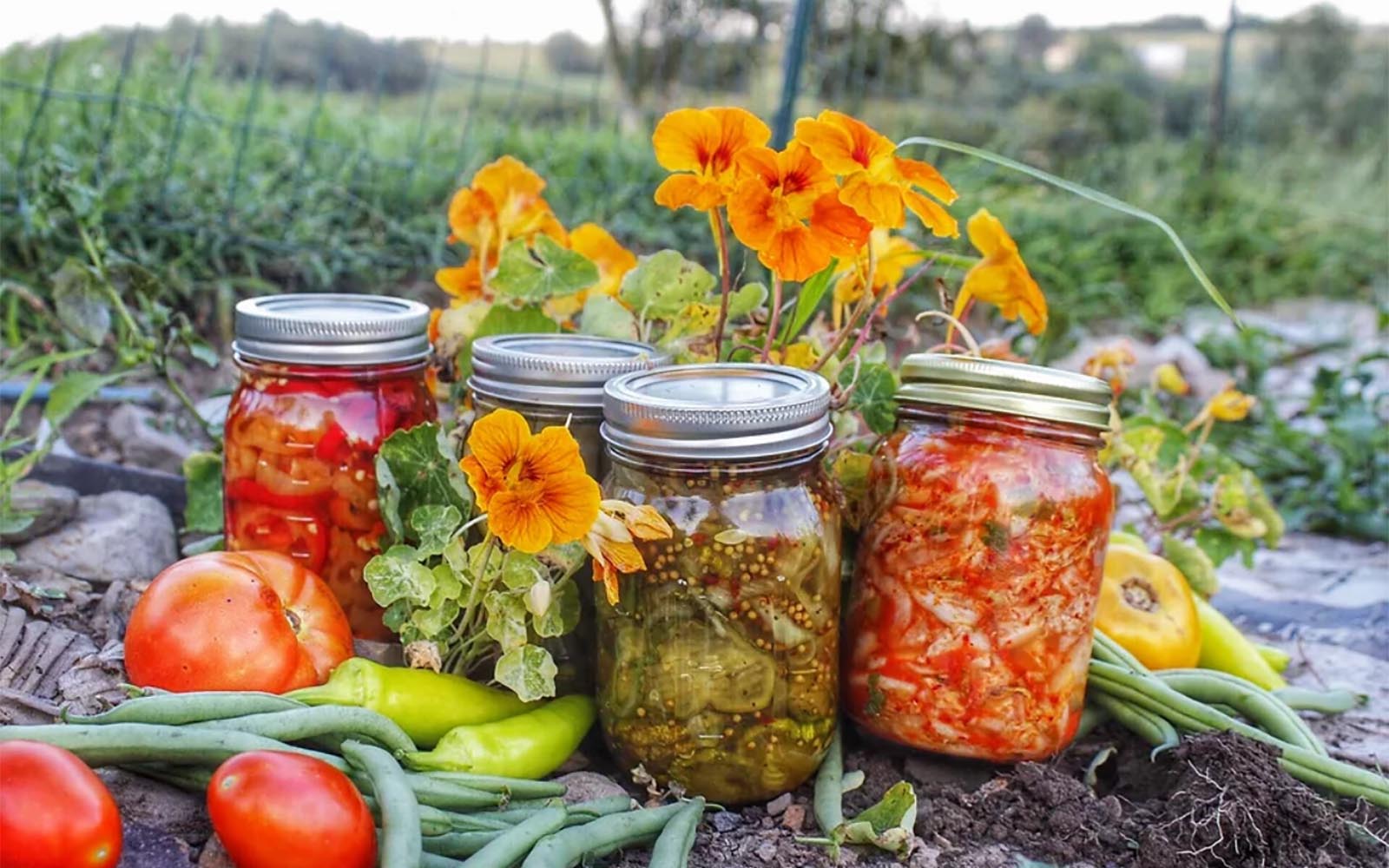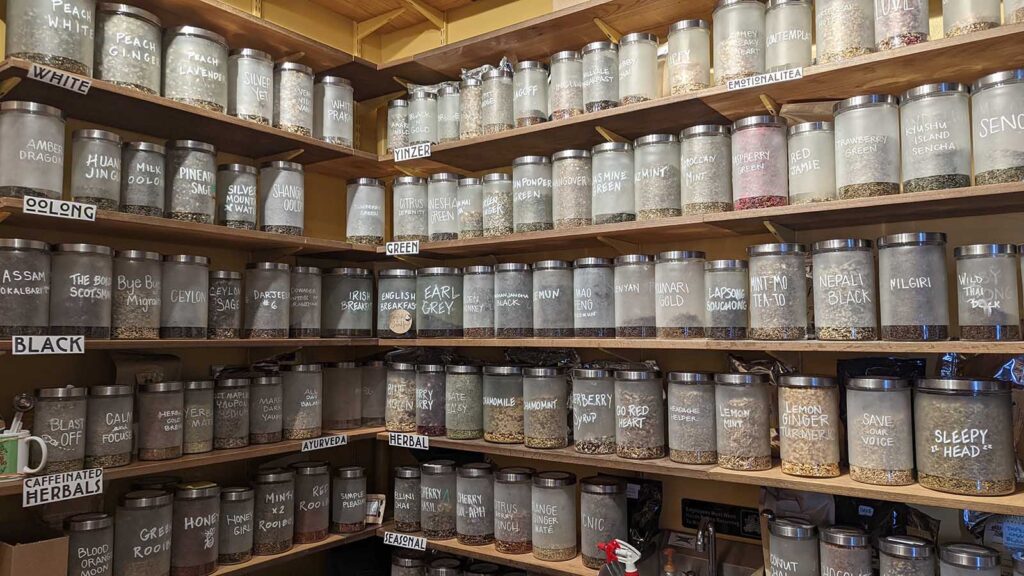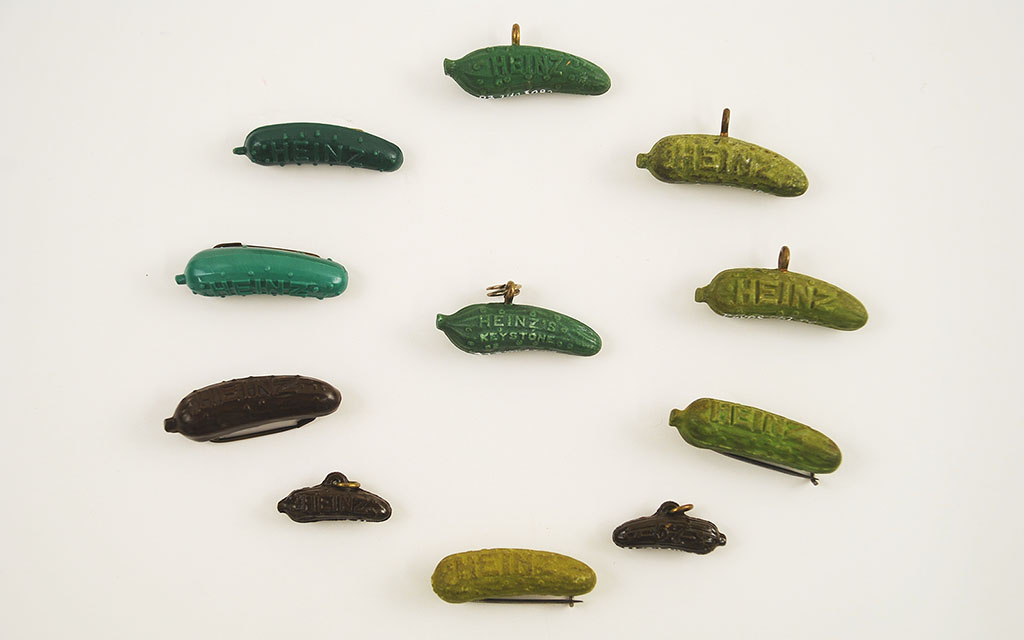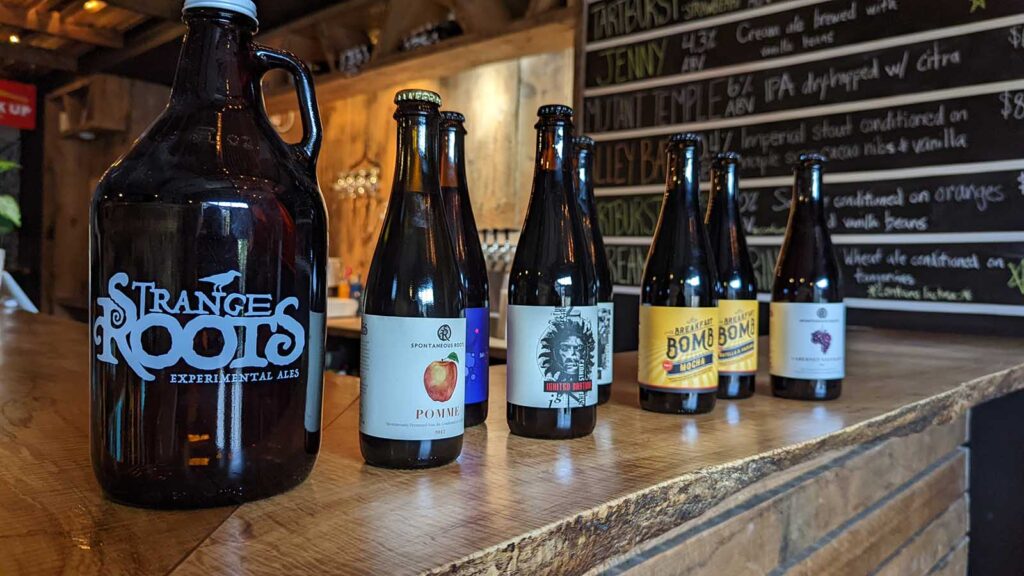
A display of pickled and fermented products. Image courtesy of The Pickled Chef, Latrobe.
Exploring PA in a Tasty Way—Culinary Trails
This week we are excited to shine a spotlight on the Center for Regional Agriculture, Food, and Transformation (CRAFT) at Chatham University. The CRAFT team created four culinary trails for the Pennsylvania Department of Community and Economic Development—trails that highlight the foodways traditions in southwestern Pennsylvania and throughout the Commonwealth. In the article below, guest writer and Program Manager for CRAFT, Cynthia Caul, offers a taste of the Pickled trail.
By Cynthia Caul, Program Manager, CRAFT at Chatham University

“Pickled: A Fermented Trail” Offers Travelers Unexpected Flavors and Variety
Do you know what cheese, vinegar, wine, hot sauce, beer, olives, and yogurt all have in common? They are all (or at least often are) fermented foods.
What is fermentation exactly? The production of energy from nutrients in the absence of oxygen using a community of bacteria and yeast.
There are also different types or processes of fermentation. For example, some processes require “feeding” this community of bacteria and yeast. You may have heard of this, or even become intimately familiar with it, during the renaissance of sourdough and other bread baking we witnessed at the outset of the pandemic. Some fermentation processes involve “culturing,” where the bacterial community (or mother culture, as some refer to it) is added at the outset. Butter and cheeses are fermented in this way. Still other processes are wild or spontaneous, where the community or culture presents naturally and begins the fermentation process, creating a rich regional terroir—a taste that can only be produced in that specific place because of its unique soil, climate, and surrounding environment.
Got it? It’s okay if you don’t. You don’t need to understand all the scientific intricacies behind fermentation to enjoy and appreciate the fermented foods featured on our Pickled: A Fermentation Trail.
It’s similar to how people often debate whether tomatoes are a vegetable or a fruit. Scientifically, however, there isn’t really much to debate. Tomatoes are, in fact, fruits. And so are cucumbers and zucchini because they bear seeds and grow from the flower of the plant. Botanically, this is what makes a fruit a fruit.
You know what else? Strawberries aren’t berries.
And you know what is a berry? A tomato.
This may feel relevant for those of you who find yourself saying, “I don’t like fruit on my salad,” when you may more specifically mean, “I don’t like (insert apples, strawberries, cranberries, sweet things, etc.) on my salad.” But ultimately, it’s not that relevant at all. You can keep saying the former, even if you mean the latter, and everyone will know what you mean.
That’s culture. Culturally, the debate about whether a tomato is a fruit or a vegetable is far richer. There is a science to food. But food is also, and just as importantly, cultural. It’s spiritual. It’s about taste, and no single one of us can experience taste in the exact same way.
 All of this is just one example of what we mean when we say we took a “food systems” approach to creating these four culinary trails or when we say we take a “holistic” approach to food systems. We’re not just referring to how a plant reproduces or where its seeds are housed. We’re referring to how the food was cooked or grown, who cooked or grew it, and for whom. How and when was it eaten? What was the experience? What significance did that experience hold for a community?
All of this is just one example of what we mean when we say we took a “food systems” approach to creating these four culinary trails or when we say we take a “holistic” approach to food systems. We’re not just referring to how a plant reproduces or where its seeds are housed. We’re referring to how the food was cooked or grown, who cooked or grew it, and for whom. How and when was it eaten? What was the experience? What significance did that experience hold for a community?
In much this same vein, this trail includes pickles, even though pickling and fermenting are two different processes. They produce similar, sour tastes that many people associate with one another. Pickling refers to soaking a vegetable, fruit, or other food in a vinegar or brine. In this country, when we think of pickles, we often think of those jarred, little cucumbers, but pickles consist of much more than that. And sometimes, those jarred, little cucumbers aren’t even pickled at all. Sometimes, they’re fermented. (But don’t worry, a lot of the time, they’re pickled.)

Fermenting and pickling are both practices that have a rich history and vibrant presence in this region, and they connect us to people all over the world who have originated and used these practices to preserve and prepare a variety of foods and beverages. For example, pickling dates back to 2030 B.C.E., where it was used to preserve cucumbers in India’s Tigris Valley. And the regional favorite sauerkraut that is often associated with German traditions is actually believed to have originated in China. In fact, it wasn’t until the 1870s that this fermented cabbage really found favor in the region. Prior to that, it was once referred to as ”pickled manure” in a Chambersburg newspaper. The culture surrounding food matters, and it’s also ever-changing.
So, with all of this new or revisited information under your belt, you’re primed to take a trip through one or all of our pickled and fermented itineraries.
Here are some highlights from the itinerary for southwestern Pennsylvania:

In addition to probiotic teas and kombucha, Abeille Voyante Tea Company offers a wide selection of all kinds of tea.
Abeille Voyante Tea Co., where you can get probiotic teas and kombucha.

A variety of Heinz Pickle Pins. Image courtesy of the Heinz History Center.
Heinz History Center, where you can brush up on your pickle trivia as well as see a 160-year-old jar of pickles.

Strange Roots exists at the intersection of farmhouse brewing tradition and creative, locally-driven experimentation. They are passionate about celebrating our environment through the use of local ingredients, varying fermentation methods and micro flora, and strive to create unique artisan ales inspired by our surroundings here in the foothills of the Allegheny Mountains.
Strange Roots Experimental Ales, which carries an array of wild (remember regional terroir?) fermented beers and vinegars.
Taiwanese Bistro Café 33 with a full menu of Taiwanese dishes, including fermented favorites like stinky tofu and kimchi hot pot.
The Pickled Chef has so much pickled and fermented goodness, including pickled ramps, kohlrabi, okra, and green beans, fermented sauerkrauts, and kimchi.
Lapp’s Family Market, which carries local water kefir, yogurt, and buttermilk.
Barrel & Flow Fest, a local beer festival, which I mentioned in my first blog post on grains but is also relevant here. It’s coming up in August, and tickets are on sale now.
If you’re looking to travel a little further, you might also be interested in:
Meadville Market House with a variety of unique pickled items, including golden eggs and spicy shrooms.
Core Goods, carrying a variety of products from familfarmers, including Clarion River Organics sauerkraut and Moody Culture kombucha.
Calkin’s Creamery, a family-owned creamery since the 1880s known for their award-winning cheeses.
Mister Lee’s Noodles, located in a historic public market, serves Japanese specialties, including fermented miso, kimchi, sriracha, and house-pickled vegetables from local farms.
Franklin Fountain, where you can get a refreshing, house-made root beer float. Root beer is a fermented beverage that was commercialized in Pennsylvania in the late 1800s, with the practice itself having a longer history originated by our nation’s indigenous peoples.
If you’re planning a trip, also be sure to check out my past two blog posts on the Baked and Chopped trails we developed alongside this one at Chatham University’s Center for Regional Agriculture, Food, and Transformation (CRAFT) with regional culinary historian Mary Miller for the Pennsylvania Department of Community and Economic Development.
Happy travels!
About CRAFT
The Center for Regional Agriculture, Food, and Transformation (CRAFT) works to support robust regional food systems that are equitable, inclusive, and sustainable in Western Pennsylvania and beyond.
CRAFT works with a number of regional partners to develop culinary trails that support economic development particularly in our region’s rural communities.
These trails aim to highlight the rich heritage and food traditions of the region, as well as include the history and culture of all of the region’s historical and current residents. We take this inclusive approach in order to acknowledge, learn, and inform about the fraught and complex history of land ownership and food production in our region and country, recognizing and celebrating the contributions of displaced indigenous and enslaved peoples.
The trails provide regional farms and food businesses with increased markets and promotional opportunities, and provide tourists with a deeper understanding of the regional food system and the unique value and history of the food grown and prepared within it.
 Cynthia Caul is the program manager for CRAFT at Chatham University and graduate of the University of Pittsburgh’s Graduate School for Public and International Affairs, where she studied International Development. Cynthia’s research has focused on food and nutrition security, land access, and the role of agricultural smallholders in an increasingly globalizing economy. She also worked at the Ford Institute for Human Security, conducting research on human rights-based approaches to improving agricultural land access for women farmers and was the 2017 recipient of the Simon Reich Human Security Writing Award. Prior to her current role, Cynthia worked on public health programming in Ghana with the U.S. Peace Corps.
Cynthia Caul is the program manager for CRAFT at Chatham University and graduate of the University of Pittsburgh’s Graduate School for Public and International Affairs, where she studied International Development. Cynthia’s research has focused on food and nutrition security, land access, and the role of agricultural smallholders in an increasingly globalizing economy. She also worked at the Ford Institute for Human Security, conducting research on human rights-based approaches to improving agricultural land access for women farmers and was the 2017 recipient of the Simon Reich Human Security Writing Award. Prior to her current role, Cynthia worked on public health programming in Ghana with the U.S. Peace Corps.
If you’d like to know more about the culinary trails, check out her first post in this series, which features the Baked Trail.







